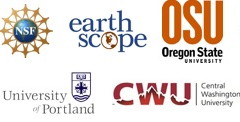October 2013 - Astoria, OR
![CEETEP participants from October 2013 workshop at GPS station TPW2 (Coast Guard Station, Astoria, Oregon) showing the direction of plate motion relative to stable North American (northeast). [Bob Lillie, OSU] CEETEP participants from October 2013 workshop at GPS station TPW2 (Coast Guard Station, Astoria, Oregon) showing the direction of plate motion relative to stable North American (northeast)](/sites/ceetep.oregonstate.edu/files/workshops/2013-10-astoria/astoria-gps-group.jpg) Astoria Workshop
Astoria Workshop
Clatsop Community College
October 11-14, 2013
Detailed Agenda
Workshop Presentations and Activities:
Presentations by the CEETEP team and invited scientists, educators, and emergency management specialists provided background on Pacific Northwest tectonics, earthquake and tsunami hazards, and community preparedness.
Download Presentations:
Related files can be found on the workshop DVD and USB drive.
Introductions: CEETEP, EarthScope, Participants, Instructors (Beth Pratt-Sitaula)
Beauty and the Beast: Plate Tectonics and Geological Hazards of the Pacific Northwest (Bob Lillie)
Basics of Earthquake and Tsunami Science and Hazards and Related Teaching Activities (Bob Butler, Bonnie Magura, Roger Groom)
Preparedness for Distant Tsunami and Surviving an Earthquake (Pat Corcoran, Bob DeGroot)
Cascadia Earthquakes and Tsunami and Related Teaching Activities (Bob Butler, Bonnie Magura, Roger Groom)
Preparedness and Surviving Local Tsunami Event (Althea Rizzo)
Native American Oral Histories (Beth Pratt Sitaula)
Exchange of Pedagogies: Interpreting the "Beauty and the Beast" Story along the Cascadia Coast (Bob Lillie)
Digital Resources (Beth Pratt-Sitaula, Bob DeGroot)
Preparedness for Post-event Personal and Community Survival (Althea Rizzo)
Tsunami Vertical Evacuation Structures (Roger Groom)
Breakout sessions provided participants with opportunities to use their “Tool Box” of teaching supplies, maps and posters. Demonstrations led by experienced classroom teachers helped familiarize participants with their Workshop Notebook filled with plate-tectonic, earthquake, tsunami, and emergency preparedness activities.
Download Activities:
Related files can be found on the workshop DVD and USB drive.
1-Human Waves Demonstrate How Seismic Waves Travel
2-Foam Faults
3-SeismicWaves and SeismicEruption
4-Plotting Earthquake Epicenters
5-Earthquake Location
6-USArray Seismic Wave Visualizations
7-World Map of Plate Boundaries
8-Seismic Slinky
9-Earthquake Machine
10-Pasta Quake
11-Earthquake Hazard Maps & Liquefaction
12-Build a Better Wall
13-Base Isolation for Earthquake Resistance
14-Pacific Northwest Tectonic Block Model
15-Cascadia GPS (Gumdrop GPS)
16-Advanced GPS Activity—Locked & Loading
17-ETS (Episodic Tremor & Slip)
18-BOSS Model
19-Types of Pacific NW Earthquakes & the BOSS Model
20-Cascadia Tsunami Geology Photo
21-Turbidites in a Jar
22-Cupcake Geology
23-Dendrochronology
24-Tsunamis and Floods in Native American Oral Tradition and Mythology
25-Emergency Backpack and Emergency Planning
26-Earthquake Hazard Inventory & Mitigation Planning
27-Investigating Factors Affecting Tsunami Inundation—A Science Inquiry
28-Tsunami Vertical Evacuation Structures
29-GPS Cards
30-Next Generation Science Standards
Field Trip:
The field trip day began with a visit to the GPS station located at the Tongue Point Naval Station, where participants learned how EarthScope instrumentation continuously measures and transmits data on plate-tectonic movements. On the beach boardwalk in Long Beach, Washington, Pat Corcoran led discussions about how low-lying coastal communities face challenges from the dangers of earthquakes and tsunamis. In Ilwaco, the group did a tsunami evacuation walk to high ground next to the high school, discovering firsthand the very real evacuation challenges for visitors and residents. The group then traveled up the east side of Willapa Bay to explore the north bank of the Niawiakum River, led by Brian Atwater of the U. S. Geological Survey, one of the first researchers to document and interpret evidence for Great Cascadia Subduction Zone Earthquakes. Participants observed tsunami geology in the riverbank and took cores of tsunami sand sheets and intertidal marsh layers buried during the last great earthquake and tsunami in January of 1700.
Astoria Workshop Field Trip Guide
Action Teams:
Participants were organized into Action Teams with a mix of teachers, interpreters, and emergency management educators from coastal communities. On the final day, each team presented an interpretive skit incorporating CEETEP science and preparedness. They also began plans for group projects later presented at the March 2014 Share-a-Thon
Download Group Interpretive Program Presentations
